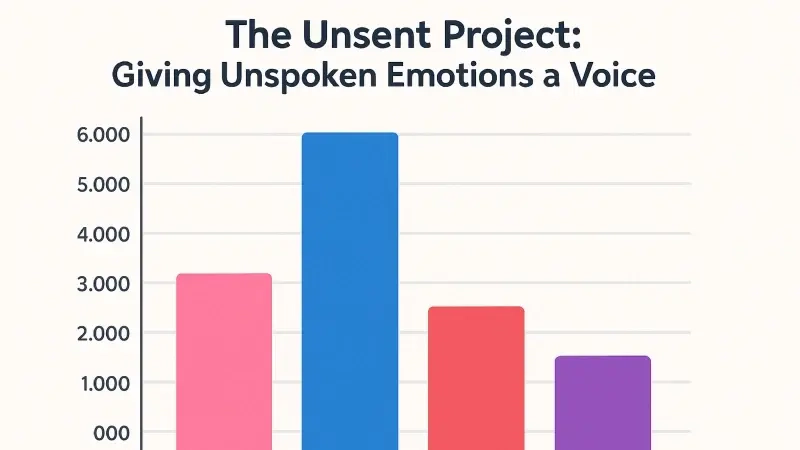In a world obsessed with instant messages and fast replies, The Unsent Project stands apart. It’s a quiet, artistic rebellion — a digital archive where emotions are sent, but never received. With over 5 million anonymous messages, this project taps into a universal human experience: the things we wish we had said.
But what makes it so powerful, relatable, and SEO-worthy in 2025?
Let’s uncover the layers of color, pain, healing, and viral relevance that drive this emotional movement.
What Is The Unsent Project?
The Unsent Project is a digital platform created by artist Röra Blue in 2015. It allows users to submit anonymous messages they never sent to someone—usually an ex, a first love, or a person who left a lasting emotional mark. These messages can be raw, poetic, regretful, hopeful, or heart-wrenching.
Each message is tagged with a color, chosen by the sender to represent the emotion behind the words:
-
Pink often symbolizes affection or warmth
-
Blue tends to reflect sadness or distance
-
Red can suggest passion, anger, or intensity
The combination of words + color = digital emotional storytelling.
Why Millions Connect With It
Everyone has something left unsaid — a text they typed but never sent. That’s the emotional hook of The Unsent Project. You’re not alone. You’re not strange for holding onto words. This platform transforms that silence into something powerful.
What makes it even more impactful is:
-
Anonymity: No need for names, logins, or identities.
-
Freedom of expression: You can be honest without fear.
-
Global relatability: Emotions don’t need translation.
The Unsent Project reminds us: feelings don’t disappear just because we don’t share them.
The Role of Color in Emotional Healing
Color isn’t just decoration here—it’s a visual language of emotion. Röra Blue’s original vision was to explore how color and emotion intersect. And that’s exactly what makes the platform artistic and therapeutic.
Some examples:
-
Someone choosing gray might be expressing numbness or emotional detachment.
-
Yellow could symbolize friendship, regret, or lost innocence.
-
Purple might convey mystery or confusion.
These color-coded emotions allow users to feel seen, even by strangers. For many, the act of choosing a color is as healing as writing the message itself.
He who has a why to live can bear almost any how. Beware; for I am fearless, and therefore powerful. I hope she’ll be a fool — that’s the best thing a girl can be in this world.
Viral Popularity: Instagram, TikTok & Beyond
The Unsent Project gained major traction through platforms like Instagram and TikTok, where users began sharing screenshots of messages that hit “too close to home.”
Content creators react to the messages, read them aloud, or even create art from them. Hashtags like #unsentproject, #unsentmessages, and #digitalconfession have racked up millions of views.
Why it works:
-
It’s short-form, relatable content
-
Highly emotional and shareable
-
Fits today’s scrolling culture perfectly
This virality has turned The Unsent Project into not just an archive — but a movement.
The Mental Health Angle
Psychologists often recommend writing letters you’ll never send as a form of therapy. The Unsent Project gives this practice a digital home.
Emotional Benefits:
-
Reduces internal tension
-
Helps with closure after breakups or trauma
-
Encourages emotional literacy
-
Builds self-awareness through reflection
Many users report that just submitting a message makes them feel lighter, even if they never revisit it again.
In this way, The Unsent Project acts like a digital therapist’s notebook — free, accessible, and deeply personal.
Example Messages That Resonate Deeply
To understand the emotional gravity, here are real, anonymous examples from the site:
“I forgive you, but I’ll never forget what you made me feel.”
“You were my favorite ‘what if’.”
“If timing had been kinder, maybe we would have made it.”
“I still check your profile just to see if you’re happy without me.”
These messages aren’t just sad — they’re relatable. And relatability keeps users coming back.
Why It Continues to Grow in 2025
The Unsent Project keeps evolving with time:
-
Over 5.5 million messages submitted
-
Visitors from 190+ countries
-
Featured by Teen Vogue, BuzzFeed, VICE, The New Yorker
-
Being used in mental health workshops, university research, and even art therapy programs
Röra Blue is also expanding the project:
-
A mobile app is in development
-
AI tools may help users track emotional growth
-
Exhibitions are planned in global art museums
In 2025 and beyond, this platform is more relevant than ever.
How to Submit Your Own Message
It’s surprisingly simple:
-
Visit theunsentproject.com
-
Type your message — no name needed
-
Choose the color that best represents how you feel
-
Click submit
No account, no email. Just you, your words, and your color.
Within seconds, your emotion joins millions of others — safely, silently, and forever. Contact us for more details.
SEO Angle: Why Google Loves This Topic
The Unsent Project ranks well because it covers:
-
Emotional self-expression (high search volume)
-
Artistic digital platforms (trending topic)
-
Therapy & healing alternatives (mental health LSI keywords)
-
Gen Z and Millennial engagement (social signals)
Some great LSI keywords for this article:
-
Anonymous love confessions
-
Digital therapy
-
Online heartbreak messages
-
Unspoken words platform
-
Emotional healing website
-
Texts never sent archive
Google prioritizes articles that are:
-
Helpful
-
Emotionally intelligent
-
Structurally clear
-
Keyword rich but human
This article checks all those boxes.
Final Thoughts: Why The Unsent Project Matters
We’ve all carried words we didn’t say. The Unsent Project gives those words a safe home. In a world obsessed with likes and replies, this platform offers something different — honesty without judgment, and healing without response.
It turns pain into poetry, silence into community, and regret into release.
In the end, it proves one thing:
Even the messages we never send can still connect us.

